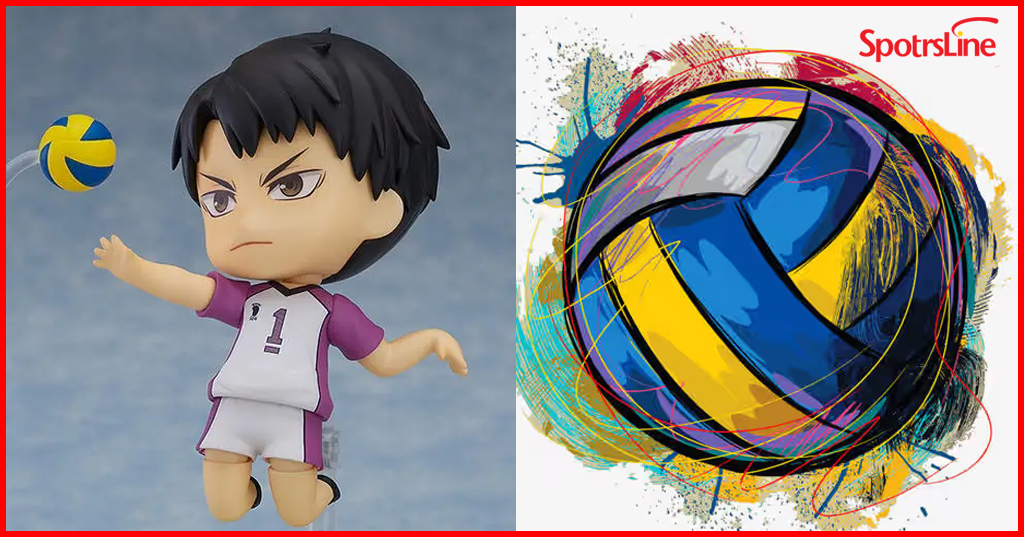
Let’s read and know about Volleyball Rules
The first two chapters talked about the basics of passing and serving. This chapter explains the Volleyball rules to beginners.
Volleyball court

The volleyball court is a rectangle of 18 meters by 9 meters, with at least 3 meters of open space around it and no obstacles within 7 meters above the court. A line is drawn horizontally in the middle of the court to divide the court into two equal areas. All lines are 5 cm wide.
The height of the volleyball net is 2.24 meters for women and 2.43 meters for men.
There is a 1.80-meter-long marker pole connected to the outside of each end of the net.

Player Positions
There are six main techniques in volleyball: serving, setting, passing, spiking, blocking, and defending. Usually, according to the team’s tactics, players in each position have their own expertise. The most common position allocation includes three positions: attacker (divided into main attacker, secondary attacker, and receiver), setter, and libero.
Freeman
The libero is a full-time defensive player, mainly responsible for the first pass and defense. Usually the libero has the fastest reaction speed and the best first pass technique in the team. Since the libero does not need to attack in front of the net, there is no special requirement for the libero’s height. In the game, the libero wears a different color jersey from other players. In particular, the libero can replace different players at will in the same game without occupying the substitution quota.
Setter
The setter’s responsibility is to organize the team’s offense. They are responsible for sending the ball to the attacker’s most suitable position for spiking during the second pass. Fast movement and accurate passing are essential qualities for a setter. A good setter can use the characteristics of each attacker to organize fast and changeable tactics, so the setter must have a good understanding of the characteristics and habits of the attackers in each position of the team, and keep a clear mind and thinking during the game.

Main attack, support
The main attacker is the player who attacks near the marker. A right-handed main attacker is best suited to attack at position 4 (main attacker), whereas a left-handed main attacker is best suited to attack at position 2 (receiver). Since most of the balls passed by the setter to the main attacker position are high balls, the main attacker often uses a long run-up and has ample time to run up and jump.
In the offense, the main attacker usually relies on powerful smashes to score. The main attacker also needs to master the first pass technique, because they are usually the second first pass point besides the libero when the opponent serves. With the development of volleyball, the back row main attacker not only needs to receive the first pass, but also has the task of attacking, so in the game, there are usually four attack points.

Secondary Attack
The secondary attacker is a player who often plays fast break near the setter. The secondary attacker specializes in blocking because they must block the fast break from the opponent’s secondary attacker and need to move quickly from the center to both sides to organize a double block. Usually the secondary attacker is the tallest player in the team and is required to have good defensive skills.
Competition Rules
1. Volleyball matches are played in a best-of-five format. The first four games are played in a 25-point format. A team wins a game only if it wins at least 25 points and exceeds the opponent by 2 points.
2. The deciding game adopts a 15-point system. After one team scores 8 points first, the two teams exchange courts and continue the game in the original position order until the end. The first team to score 15 points and lead the opponent by 2 points wins.
Serve
The server must serve the ball within 8 seconds after the first referee blows the whistle to allow the serve. After the ball is tossed or the ball holder withdraws, the ball must be hit with one hand or any part of the arm before the ball hits the ground. The ball can only be tossed or withdrawn once, but bouncing or fiddling with the ball in the hands is allowed. The server must not step on the ground outside the court (including the end line) and the serving area when hitting the ball or jumping to hit the ball. After hitting the ball, you can step on or land inside the court or outside the serving area.
Methods of playing volleyball
1. During the game, each team has 6 players on the court, standing in the front and back rows. The game starts when the player on the right side of the back row of the side that gets the right to serve hits the ball over the net with one hand or arm in the serving area. Each side can hit the ball up to 3 times (except for blocking) to make the ball go over the net. The ball cannot be held. The same player cannot hit the ball twice in a row.
The game continues uninterrupted until the ball falls to the ground, goes out of bounds, or one team cannot hit the ball back. When the serving team wins a point, the original serving player continues to serve; when the receiving team wins a point, it gets the right to serve and rotates in a clockwise direction, with the front row right player turning to the back row right to serve.
2. Hitting the ball during the game: Any part of the player’s body is allowed to touch the ball
(1) Four hitting fouls: Each team may hit the ball back to the opponent’s court a maximum of three times (excluding blocking). If more than three times are allowe, it will be consider a four hitting foul.
(2) Holding foul: If a player fails to hit the ball clearly when hitting it, or if there is a long pause when touching the ball, such as scooping, holding, pushing, or carrying the ball, he should be call for a holding foul.
(3) Continuous Foul: If a player hits the ball twice in succession, or the ball touches different parts of his body in succession, it is consider a continuous foul.
Offline traversal
A player is allowe to cross under the net into the opponent’s court without interfering with the opponent’s play . A player’s foot (or both) or hand (or both) partially crosses the center line and touches the opponent’s court, while the rest of the foot (or both) touches the center line or is above the center line. No other part of the player’s body is allowe to touch the opponent’s court. Players may enter the opponent’s court after a break in play.
Go online
It is not a foul for a player to touch the net, except when striking the ball or interfering with play.
Offensive hitting
Except for serving and blocking, all shots directly to the opponent are offensive shots. Front row players can complete offensive shots at any height, but they must be in their own space when they touch the ball. Back row players can complete offensive shots at any height behind the offensive line, but their feet must not step on or cross the offensive line when they jump, and they can land in the front court after hitting the ball.
Block
Only the front row players are allowe to complete the block, and the back row players are not allowed to complete the block.
Do beginners understand?


One thought on “Let’s read and know about Volleyball Rules”